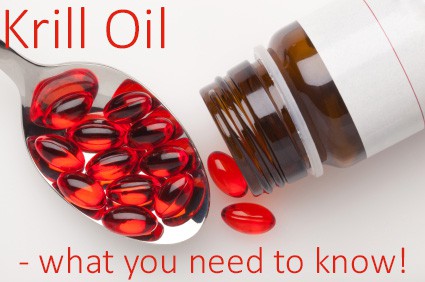Krill oil is becoming increasingly popular, and many people use it as an alternative to fish oil, since both provide the long-chain “marine” omega-3 fatty acids EPA and DHA.
In addition, krill oil has some unique properties, and marketing claims about krill oil’s purported superiority over fish oil abound, centering on the following:
– Krill oil provides some of the EPA and DHA in phospholipid form, which has been suggested to be absorbed more effectively.
– Krill oil contains astaxanthin, a carotenoid with health promoting effects.
– Krill oil contains the essential nutrient choline.
– There are supposedly fewer contaminants in krill oil than fish oil.
– Krill oil supposedly does not cause any fishy burping or other gastro-intestinal side effects.
In this article I will summarize the research on each of these points, and critically evaluate the related marketing claims…
Molecular form of the fat molecule – triglyceride vs. phospholipid
Dietary fat is mainly in the form of triglyceride, the chemical name for fats and oils. These molecules are made up of 4 parts: a glycerol backbone to which three fatty acids are attached.[1] Triglycerides make up 90-95% of the fat we consume in foods.[2]
Another type of dietary fat is phospholipids. These molecules are similar to triglycerides except that the third fatty acid is replaced by a phosphate group that links to a head group (which is typically choline).[1]
In krill oil, some the EPA and DHA is in a phospholipid form and some is in the triglyceride form; in fish oil, they are only in the triglyceride form. It should be noted that commercial krill oil products vary widely, with as little as 19% to 58% of the EPA+DHA being contained in the phospholipid form.[3, 4] In krill oil products currently available on the market, around 30-40% of the EPA+DHA is in the phospholipid form, with the rest in the triglyceride form and a smaller amount in free fatty acid form. Bottom line is that only a portion of the omega-3’s in krill oil are in the phospholipid form. This is important to remember in discussions of krill oil vs. fish oil (see below and an upcoming article on the topic).
It is often claimed that EPA and DHA from krill oil is better absorbed than from fish oil, because phospholipids are supposedly better absorbed than triglycerides. However, there is not much research on this, and data are conflicting. One study found that absorption of EPA and DHA was higher in infants fed a formula containing these fatty acids in the form of phospholipids vs. triglycerides.[5] In contrast, another study that investigated whether phospholipid- or triglyceride-bound DHA was more readily incorporated into red blood cells membranes of term infants showed little difference. What was more important was the fat composition of the overall fat intake rather than the molecular structure (phospholipid vs. triglyceride) in which they are delivered.[6] This was confirmed in another study.[7] Therefore, it appears that absorption of EPA and DHA (at least from infant formulas) depends mainly on the overall fat content and composition of the formula, and that increased intake of EPA and DHA should be encouraged – regardless of their molecular form.[7]
Nevertheless, there are indications that DHA from krill oil, compared from fish oil, may be preferentially incorporated into red blood cell membranes [8] and the brain.[9-13] Regarding neurological and brain-related effects, one study found that supplementation with EPA + DHA in phospholipid form increased visual sustained attention performance in children with inattention compared to the triglyceride form.[14] Another study in healthy elderly found greater improvement in cognitive function after supplementation with krill oil than fish oil.[15]
However, in both these studies low doses of EPA and DHA were used. Bearing in mind that fat composition of the diet and the total amount of EPA and DHA ingested may be more important than the source of EPA and DHA [7], no conclusion about the relative efficacy of EPA and DHA from krill oil vs. fish oil can be made until proper dose-escalation studies are conducted. None have been done so far.
Because the main marketing claim for krill oil states that it is better absorbed and has a greater – some even go as far as saying “superior” – bioavailability that fish oil, I will dedicate a separate upcoming article to this topic.
Astaxanthin
It is true that krill oil contains astaxanthin, which is not found in fish oil. Astaxanthin is a type of a carotenoid found in microalgae and krill [16]. It gives krill oil and salmon (and flamingos!) their pink color. Astaxanthin has several potential health promoting effects.[17, 18] For example, it may be able to slow the progression of neurodegenerative diseases.[19, 20]
However, in order to get any health benefits from astaxanthin, large doses are needed. A study showed that daily doses of 6-12 mg astaxanthin are needed to boost HDL-cholesterol (the ‘good’ particle) levels, while 12-18 mg are needed to increase levels of adiponectin (a health promoting adipokine) and reduce levels of blood fats (triglycerides).[21]
Krill oil provides only 50 to 200 microgram (i.e. 0.05 to 0.2 mg) per 1000 mg (1 gram) capsule. Thus, to get an effective dose of 6 mg astaxanthin you would have to swallow 30 to 120 grams of krill oil. Most krill oil products contain 0.5 or 1 gram per soft gel; thus, this translates to somewhere between 30-240 soft gels per day, which is both practically and financially nearly impossible! If you want effective doses of astaxanthin, it is far more convenient – and a lot cheaper – to just take an astaxanthin supplement.
Choline
Choline was officially recognized as an essential nutrient by the Institute of Medicine (IOM) in 1998.[22] It is a relatively unknown nutrient, which deserves far more attention than it has been getting [23]. (I will cover it more in an upcoming article).
As mentioned in the introduction, the most common “phosphate head group” in phospholipids is choline, and most of the phospholipids in krill oil are phosphatidylcholine (the chemical name of this particular phospholipid molecule). Therefore, krill oil is a source of choline.[24] However, krill oil contains only about 34 g phosphatidylcholine per 100 gram oil, i.e. 340 mg per 1 gram oil.[24] Of this, only 13% is choline itself; thus, krill oil provides about 44 mg choline per 1 gram.
To put this in perspective, the recommended adequate intake (AI) for choline is 550 mg/day.[22] The estimated mean daily intake of choline from food in US adults is 302 mg.[25] Thus, choline is a shortfall nutrient.
While 1000 mg (1 g) of krill oil can help you cover your choline requirement, the cheapest – and by far most nutritious – source of choline is egg yolk. One large egg yolk provides 116 to 190 mg choline.[26] Thus, 1 egg yolk provides 3-4 fold more choline than you get from 1 g of krill oil, without the added cost of krill oil.
Contaminants / Pollutants
It is commonly stated that krill oil is naturally free of toxins and pollutants. The rationale is this: krill is near the bottom of the sea food chain and are caught (mostly) in the relatively clean waters around Antarctica. These two factors should help keep pollutant levels low. It is also sometime claimed that the relatively short lifespan of krill limits the amount of contaminants it can accumulate. However, Antarctic krill live to 5-7 years, which is comparable to – or even longer than – fish species commonly used in fish oil production.[27] In addition, Antarctic krill are highly adaptable feeders; in addition to their herbivorous feeding of phytoplankton (i.e. microalgae) they also eat copepods, zooplankton and detritus (decomposing plant and animal parts, as well as feces).[28] This makes it hard to predict their pollutant levels[28] so directly measuring them is the best way to examine the question.
A comprehensive analytical survey of pollutants in Antarctic krill found that they contain notable levels of hexachlorobenzene (HCB) and p,p’-dichlorodiphenyl dichloroethylene (p,p’-DDE).[29, 30] A follow-up study examined levels of pollutants in commercial krill oil and fish oil products, and compared the pollutant levels in these two classes of supplements.[31]
It was found that none of the categories or products analyzed, even at their highest recommended dose, came close to the tolerable daily intake levels for any single contaminant. However, they all contained several different contaminants. Chlorobenzenes (penta- and hexa-) were found in eight of eleven products at levels ranging from 27–9900 pg at the maximum daily dose of oil. Surprisingly, krill oil products contained higher levels of chlorobenzene than several fish oil products.
Polychlorinated biphenyls (PCBs) were detected in all products. Only the krill oil products contained multiple dioxins and furans. Toxicity equivalencies (TEQ) are available for dioxins, furans and some PCBs. Notably, krill oil featured among the top five highest ranking TEQ products, which also included some low-grade fish oil supplements. High-quality fish oil supplements contained less dioxins, furans and PCBs because these contaminants are efficiently removed by common fish oil cleaning processes (which does not affect the nutritional quality of the fish oil).[32]
Thus, marketing krill oil as being naturally free of toxins and pollutants is clearly not true, however, the levels of these contaminants that one would typically consume by taking krill oil are far below harmful levels. Therefore, the contaminant issue is more about marketing than about a real health concern.
What about the “fishy burping”?
Fish oil is infamous for causing “fishy burps”. Krill oil marketers used this to their advantage, claiming the krill oil does not cause fishy burps. However, a look at the raw data in krill oil studies refutes this, even though most study abstracts state that krill oil is well tolerated.
In one frequently cited study, subjects in both the fish oil and placebo (corn oil) groups had 1 report each of burping of mild and moderate intensity.[33] However, there were 4 and 3 reports of mild and moderate burping in the krill oil group. There were 3 report of mild aftertaste in the fish oil group, but 6 reports of mild aftertaste and 1 report of a stronger aftertaste in the krill oil group. There was 1 report of mild bloating in the fish oil group and 2 reports in the krill oil group. Constipation was only reported in the krill oil group. No statistical analysis was done to compare the frequency of these adverse events between groups, nevertheless the study abstract concludes that “krill oil was well tolerated with no adverse effects”.
Similarly, another study shows increased incidence of gastrointestinal side effects after krill oil compared to fish oil; gas/bloating, 5 vs 0; flatulence, 9 vs 2; diarrhea, 5 vs 2.[34] The increased incidence of gas/bloating and flatulence in the krill oil group over that seen in the fish oil group was statistically significant. In spite of this, it was stated in the study abstract that “No significant differences for other safety variables were noted, including adverse events”.[34]
While burping is clearly not a serious adverse effect, krill oil may have no advantage over fish oil in this regard, and it does not appear to be a substantiated claim.
Cost – price per mg of EPA+DHA
As I will explain further in the upcoming article, regardless what source you use to cover your EPA + DHA needs – krill oil, fish oil or fatty fish – you need to keep an eye on the EPA + DHA content.
In this regard, krill oil has a clear disadvantage. The average cost per 1000 mg krill oil – which typically provides only around 200 mg EPA + DHA – is $1.
Compare this with a fish oil concentrate, such as Minami Nutrition MorEPA® Platinum Ultimate www.vitacost.com/minami-nutrition-morepa-platinum-ultimate-once-daily-omega-3-d3-orange, which provides 890 mg EPA + DHA per 1000 mg – at a cost of $0.68.
To get 890 mg EPA + DHA from krill oil you would have to swallow 4-5 gram, corresponding to 8 to 10 soft gels, for a cost of $4.5.
Another good fish oil concentrate is Barlean’s Ideal Omega 3 www.vitacost.com/barleans-ideal-omega-3-orange-1000-mg-60-softgels, which provides 800 mg EPA + DHA per 1000 mg – at a cost of $0.55. Again, you would have to pay 4 times more to get this amount from krill oil.
How much EPA + DHA do you need per day?
With all this discussion about EPA + DHA content and bioavailability, you may wonder “how much EPA + DHA do I need then”? The first thing to know is that “need” is relative depending on what your goals is.
Currently there is no RDI (Recommended daily allowance) for EPA and DHA, but for health promotion and cardiovascular disease prevention, it has been suggested that 1000 mg/day of EPA + DHA is advisable.[35] However, people who have elevated blood fats (triglycerides) need 2000 to 4000 mg per day to achieve a therapeutic benefit.[36] Higher doses of EPA + DHA are also needed if your goal is to improve your body composition; fish oil supplementation can induce fat loss as well as an increase in muscle protein synthesis. I covered these effects in previous articles:
Fish Oil for Muscle Growth and Prevention of Muscle Loss with Aging
Fish Oil for Fat Loss – can it really help you get in shape?
US adults consume on average only 23 mg EPA per day and 63 mg DHA per day from food alone.[37] Thus, supplementation clearly needs to be considered to help people meet recommendations for these long-chain omega-3s.
Summary
Krill oil marketers have seemingly ascribed some magical properties to the phospholipids in krill oil, but these claims don’t hold up under scrutiny.
First, in contrast to what most consumers think, the phospholipid content in krill oil products is typically less than its content of triglycerides (which is what you find in fish oil). So much for the consumer impression that krill oil is all phospholipid.
Second, the amounts of astaxanthin and choline in krill oil are miniscule and not enough to confer any significant health benefits.
Third, krill oil is not “naturally free of toxins and pollutants,” and it can have as much or more than fish oil. But in either case, the levels are vanishing low so neither presents a health hazard.
Finally, if you think krill oil will free you from fishy burps, gas/bloating and flatulence, you may be in for a surprise!
Bottom line, krill oil is a typical example of supplement manufacturers and marketers – and in some cases study authors – selectively and misleadingly reporting study data to their advantage, and making grand extrapolations that have no basis in clinical research.
To cover your needs of EPA and DHA, you can take fish oil or krill oil – but because the latter has less EPA and DHA per gram, you’ll need to take far more capsules to get the same EPA + DHA dose. At a much greater cost!
In an upcoming article I will summarize and comment on the available human studies that have compared krill oil to fish oil. After that discussion you will realize that the supposed “superior” bioavailability of EPA + DHA from krill oil is not that superior. Thus, taking a regular dose of krill oil will only provide you a very minor dose of EPA + DHA, that will not cover your EPA + DHA needs to achieve most health benefits that research has showed with fish and/or fish oil.
———————————————————————————————————————————————–
About Monica Mollica > www.Ageless.Fitness

Monica Mollica holds a Master degree in Nutrition from the University of Stockholm / Karolinska Institue, Sweden. She has also done PhD level course work at renowned Baylor University, TX.
Having lost her father in a lifestyle-induced heart attack at an age of 48, she is a strong advocate of primary prevention and early intervention, and the development of lifestyle habits for health promotion at all ages.
Today, Monica is sharing her solid medical research insights, real life hands on experience, and passion for health and fitness by offering nutrition / supplementation / exercise / health consultation services, and working as a medical writer specializing in health promotion, fitness and anti-aging.
She is currently in the process of writing a book on testosterone, covering health related issues for both men and women.
———————————————————————————————————————————————–
References:
1. Burri, L., et al., Marine omega-3 phospholipids: metabolism and biological activities. Int J Mol Sci, 2012. 13(11): p. 15401-19.
2. Iqbal, J. and M.M. Hussain, Intestinal lipid absorption. Am J Physiol Endocrinol Metab, 2009. 296(6): p. E1183-94.
3. Araujo, P., et al., Determination and structural elucidation of triacylglycerols in krill oil by chromatographic techniques. Lipids, 2014. 49(2): p. 163-72.
4. Ghasemifard, S., G.M. Turchini, and A.J. Sinclair, Omega-3 long chain fatty acid “bioavailability”: a review of evidence and methodological considerations. Prog Lipid Res, 2014. 56: p. 92-108.
5. Carnielli, V.P., et al., Intestinal absorption of long-chain polyunsaturated fatty acids in preterm infants fed breast milk or formula. Am J Clin Nutr, 1998. 67(1): p. 97-103.
6. Sala-Vila, A., et al., Influence of dietary source of docosahexaenoic and arachidonic acids on their incorporation into membrane phospholipids of red blood cells in term infants. Prostaglandins Leukot Essent Fatty Acids, 2006. 74(2): p. 143-8.
7. Sala-Vila, A., et al., The source of long-chain PUFA in formula supplements does not affect the fatty acid composition of plasma lipids in full-term infants. J Nutr, 2004. 134(4): p. 868-73.
8. Lemaitre-Delaunay, D., et al., Blood compartmental metabolism of docosahexaenoic acid (DHA) in humans after ingestion of a single dose of [(13)C]DHA in phosphatidylcholine. J Lipid Res, 1999. 40(10): p. 1867-74.
9. Liu, L., et al., Higher efficacy of dietary DHA provided as a phospholipid than as a triglyceride for brain DHA accretion in neonatal piglets. J Lipid Res, 2014. 55(3): p. 531-9.
10. Chen, S. and P.V. Subbaiah, Phospholipid and fatty acid specificity of endothelial lipase: potential role of the enzyme in the delivery of docosahexaenoic acid (DHA) to tissues. Biochim Biophys Acta, 2007. 1771(10): p. 1319-28.
11. Thies, F., et al., Preferential incorporation of sn-2 lysoPC DHA over unesterified DHA in the young rat brain. Am J Physiol, 1994. 267(5 Pt 2): p. R1273-9.
12. Lagarde, M., et al., Lysophosphatidylcholine as a preferred carrier form of docosahexaenoic acid to the brain. J Mol Neurosci, 2001. 16(2-3): p. 201-4; discussion 215-21.
13. Di Marzo, V., et al., Dietary krill oil increases docosahexaenoic acid and reduces 2-arachidonoylglycerol but not N-acylethanolamine levels in the brain of obese Zucker rats. International Dairy Journal, 2010. 20(4): p. 231-235.
14. Vaisman, N., et al., Correlation between changes in blood fatty acid composition and visual sustained attention performance in children with inattention: effect of dietary n-3 fatty acids containing phospholipids. Am J Clin Nutr, 2008. 87(5): p. 1170-80.
15. Konagai, C., et al., Effects of krill oil containing n-3 polyunsaturated fatty acids in phospholipid form on human brain function: a randomized controlled trial in healthy elderly volunteers. Clin Interv Aging, 2013. 8: p. 1247-57.
16. Ambati, R.R., et al., Astaxanthin: sources, extraction, stability, biological activities and its commercial applications–a review. Mar Drugs, 2014. 12(1): p. 128-52.
17. Kidd, P., Astaxanthin, cell membrane nutrient with diverse clinical benefits and anti-aging potential. Altern Med Rev, 2011. 16(4): p. 355-64.
18. Fassett, R.G. and J.S. Coombes, Astaxanthin in cardiovascular health and disease. Molecules, 2012. 17(2): p. 2030-48.
19. Barros, M.P., S.C. Poppe, and E.F. Bondan, Neuroprotective properties of the marine carotenoid astaxanthin and omega-3 fatty acids, and perspectives for the natural combination of both in krill oil. Nutrients, 2014. 6(3): p. 1293-317.
20. Wu, H., et al., Astaxanthin as a Potential Neuroprotective Agent for Neurological Diseases. Mar Drugs, 2015. 13(9): p. 5750-66.
21. Yoshida, H., et al., Administration of natural astaxanthin increases serum HDL-cholesterol and adiponectin in subjects with mild hyperlipidemia. Atherosclerosis, 2010. 209(2): p. 520-3.
22. Medicine., I.o., Dietary Reference Intakes for Thiamin, Riboflavin, Niacin, Vitamin B6, Folate, Vitamin B12, Pantothenic Acid, Biotin, and Choline. 1998, Washington (DC): National Academies Press (US).
23. Zeisel, S.H. and K.A. da Costa, Choline: an essential nutrient for public health. Nutr Rev, 2009. 67(11): p. 615-23.
24. Winther, B., et al., Elucidation of phosphatidylcholine composition in krill oil extracted from Euphausia superba. Lipids, 2011. 46(1): p. 25-36.
25. Chester, D.N., et al., Dietary Intakes of Choline – What We Eat in America, NHANES 2007-2008 in Food Surveys Research Group Dietary Data Brief No. 9. 2011. p. http://www.ars.usda.gov/SP2UserFiles/Place/80400530/pdf/DBrief/9_choline_intakes_0708.pdf Accessed Oct 10, 2015.
26. http://nutritiondata.self.com/facts/dairy-and-egg-products/113/2 Accessed October 4, 2015.
27. Nichols, P.D., Fish oil sources, in Long-Chain Omega-3 Specialty Oils, H. Breivik, Editor. 2007, The Oily Press, PJ Barnes & Associates: Bridgewater, UK. p. 23–42.
28. Nicol, S., Krill, currents, and sea ice: Euphausia superba and its changing environment. BioScience, 2006. 56: p. 111–120.
29. Bengtson Nash, S.M., et al., Persistent organohalogen contaminant burdens in Antarctic krill (Euphausia superba) from the eastern Antarctic sector: a baseline study. Sci Total Environ, 2008. 407(1): p. 304-14.
30. Poulsen, A.H., et al., Dietary exposure of Antarctic krill to p,p′-DDE: Uptake kinetics and toxicological sensitivity in a key polar species. Environmental Pollution, 2013. 175: p. 92-99.
31. Bengtson Nash, S.M., M. Schlabach, and P.D. Nichols, A nutritional-toxicological assessment of Antarctic krill oil versus fish oil dietary supplements. Nutrients, 2014. 6(9): p. 3382-402.
32. Maes, J., et al., Removal of dioxins and PCB from fish oil by activated carbon and its influence on the nutritional quality of the oil. Journal of the American Oil Chemists’ Society, 2005. 82(8): p. 593-597.
33. Ramprasath, V.R., et al., Enhanced increase of omega-3 index in healthy individuals with response to 4-week n-3 fatty acid supplementation from krill oil versus fish oil. Lipids Health Dis, 2013. 12: p. 178.
34. Maki, K.C., et al., Krill oil supplementation increases plasma concentrations of eicosapentaenoic and docosahexaenoic acids in overweight and obese men and women. Nutr Res, 2009. 29(9): p. 609-15.
35. Flock, M.R., W.S. Harris, and P.M. Kris-Etherton, Long-chain omega-3 fatty acids: time to establish a dietary reference intake. Nutr Rev, 2013. 71(10): p. 692-707.
36. Kris-Etherton, P.M., et al., Omega-3 fatty acids and cardiovascular disease: new recommendations from the American Heart Association. Arterioscler Thromb Vasc Biol, 2003. 23(2): p. 151-2.
37. Papanikolaou, Y., et al., U.S. adults are not meeting recommended levels for fish and omega-3 fatty acid intake: results of an analysis using observational data from NHANES 2003-2008. Nutr J, 2014. 13: p. 31






Great stuff… again. Wondering how either of these two sources compare to flax?
Thank you. Flax oil doesn’t even contain EPA and DHA, so it cannot be compared.
Flax only contains the short-chain omega-3 fatty acid LA. Is it not a substitute for EPA an DHA because the endogenous conversion in the body is negligible.
It does not compare as Monica mentions. Flax is covered in some vids here (use search option) with full details in BBR/FLR and books of mine found here. I was actually the first person to write about the value of flax in the bbing mags back in the day.
Wonderful research, Monica. Kudos to you. I am 100% with you. That is why I take super omega3 fish oil from Dr. Lange (fortifeye.com) and buy astaxanthin seperate from Dr. Lange as well. I never experience any burping whatsoever from Dr. Lange Omega3 fish oil. I sent you the link so you can research it as well. Thanks for sharing. No wonder you look so gorgeous, :-).
Thank you. 🙂
Like you said, high-quality fish oil supplements usually do not cause burping.
Hi Monica
I just checked your http://www.agelessforever.net/anti-aging-news-blog site and read your study on aspirin. I am very impressed. It is full of so many good information. I think I am going to check your site more often. You are doing a wonderful job. Kudos
Louis, thank you very much!! 🙂
I take fish oil from a health foo store. Only one teaspoon = 750 EPA 550 DHA and 1700mg of omega 3. It drop my cholesterol 50 points. Best trick ever. I went on Krill, and did not see any change.
See! 🙂